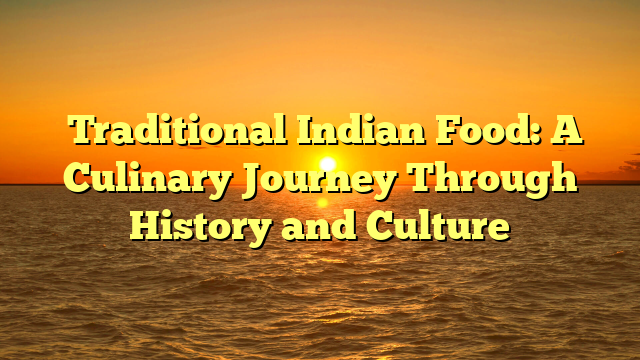
India is a land of diverse cultures, languages, and traditions, and this diversity is beautifully reflected in its cuisine. Indian food is known for its bold flavors, aromatic spices, and a deep-rooted connection to history and heritage. With a culinary tradition spanning thousands of years, Indian cuisine has evolved through influences from various civilizations, including the Mughals, Persians, British, and Portuguese. This article explores the significance of traditional Indian food, its regional variations, and some of the most iconic dishes.
The Essence of Traditional Indian Cuisine
Indian food is built on the foundation of spices (masalas) and herbs, which not only enhance flavor but also have medicinal properties. Ingredients such as turmeric, cumin, coriander, cardamom, cloves, and fenugreek are commonly used to create depth in every dish. Indian cooking is also known for its balance of six fundamental tastes, known as Shad Rasa:
1. Madhura (Sweet) – Found in sugar, jaggery, fruits, and dairy.
2. Amla (Sour) – Present in tamarind, lemon, yogurt, and vinegar.
3. Lavana (Salty) – Derived from rock salt and sea salt.
4. Katu (Pungent/Spicy) – Comes from chilies, ginger, garlic, and mustard.
5. Tikta (Bitter) – Found in bitter gourd, fenugreek, and turmeric.
6. Kashaya (Astringent) – Present in pomegranate, lentils, and raw bananas.
This harmony of flavors makes Indian cuisine unique and enjoyable.
Regional Diversity in Indian Cuisine
India’s vast geography and cultural diversity have led to the development of four primary regional cuisines, each with its distinct characteristics:
1. North Indian Cuisine: Known for its rich, creamy curries, naan, and tandoori dishes.
2. South Indian Cuisine: Famous for its rice-based dishes, coconut flavors, and fermented foods like dosa and idli.
3. East Indian Cuisine: Features mild, slightly sweet dishes with a focus on seafood and desserts.
4. West Indian Cuisine: Offers a mix of vegetarian and non-vegetarian delights, with influences from Gujarat, Maharashtra, and Rajasthan.
Now, let’s explore some of the most iconic traditional Indian dishes from different regions.
Iconic Traditional Indian Dishes
1. Biryani (बिरयानी)
Biryani is one of India’s most celebrated dishes, believed to have been introduced by the Mughals. This aromatic rice dish is cooked with fragrant basmati rice, tender meat (chicken, lamb, or goat), and a blend of spices like saffron, cardamom, and cloves. Hyderabadi, Lucknowi, and Kolkata Biryani are some of the most popular regional variations.
2. Dal Tadka (दाल तड़का)
Dal Tadka is a staple lentil dish enjoyed across India. Made from yellow lentils (toor dal) and tempered with ghee, cumin, garlic, and red chilies, this dish is simple yet flavorful. It is commonly paired with rice or Indian bread like roti.
3. Butter Chicken (मक्खन चिकन)
A beloved dish from Punjab, Butter Chicken (Murgh Makhani) features succulent pieces of chicken cooked in a creamy tomato-based gravy infused with butter, spices, and cream. Bayar4D Login is best enjoyed with naan or jeera rice.
4. Masala Dosa (मसाला डोसा)
A specialty from South India, Masala Dosa is a thin, crispy rice pancake stuffed with a spicy potato filling. It is served with coconut chutney and sambar, a lentil-based vegetable stew. This dish is a breakfast favorite in many Indian households.
5. Rogan Josh (रोगन जोश)
Originating from Kashmir, Rogan Josh is a slow-cooked lamb curry made with yogurt, red chilies, and aromatic spices. This dish is an integral part of Kashmiri cuisine and is best paired with steamed rice or naan.
6. Chole Bhature (छोले भटूरे)
A popular street food from North India, Chole Bhature consists of spicy chickpea curry (chole) served with deep-fried, fluffy bread (bhature). It is often accompanied by pickles, onions, and yogurt.
7. Pani Puri (पानी पूरी)
Pani Puri, also known as Golgappa or Puchka, is a beloved street food snack. It consists of hollow, crispy puris filled with spicy tamarind water, mashed potatoes, and chickpeas. This dish is enjoyed for its burst of tangy and spicy flavors.
8. Saag Paneer (साग पनीर)
Saag Paneer is a traditional North Indian dish made with spinach (saag) and paneer (Indian cottage cheese). It is cooked with spices, garlic, and butter, offering a rich and nutritious meal often served with makki ki roti (corn flatbread).
9. Bengali Fish Curry (माछेर झोल)
Bengali cuisine is known for its love of fish, and Macher Jhol (fish curry) is a signature dish. Made with mustard seeds, tomatoes, and aromatic spices, this curry is served with steamed rice. It showcases the simple yet bold flavors of East India.
10. Gulab Jamun (गुलाब जामुन)
No Indian meal is complete without dessert, and Gulab Jamun is a favorite. These deep-fried milk-based dumplings are soaked in a sugary syrup flavored with cardamom and rose water, making them irresistibly sweet and soft.
The Role of Traditional Indian Food in Modern Society
Despite the rise of fast food, traditional Indian food continues to hold a special place in the hearts of people. Many families still cook and pass down ancestral recipes, ensuring that culinary traditions remain alive. Festivals, weddings, and religious ceremonies are all deeply connected to food, with special dishes prepared for each occasion.
Additionally, Indian cuisine has gained immense popularity worldwide, with Indian restaurants thriving in every corner of the globe. Dishes like curry, naan, and samosas have become international favorites, showcasing India’s rich culinary heritage to the world.
Modern health-conscious trends have also embraced Ayurvedic principles of Indian cooking, emphasizing the balance of ingredients for holistic well-being.
Conclusion
Traditional Indian food is a celebration of flavors, culture, and history. Each dish tells a story—whether it’s the royal legacy of Biryani, the rustic charm of Dal Tadka, or the comforting sweetness of Gulab Jamun. As India continues to evolve, its culinary traditions remain an essential part of its identity, connecting generations and bringing people together through the universal love of food.
Whether you’re indulging in a spicy plate of Chole Bhature or savoring the warmth of homemade Masala Dosa, traditional Indian food promises an unforgettable journey for the senses.




